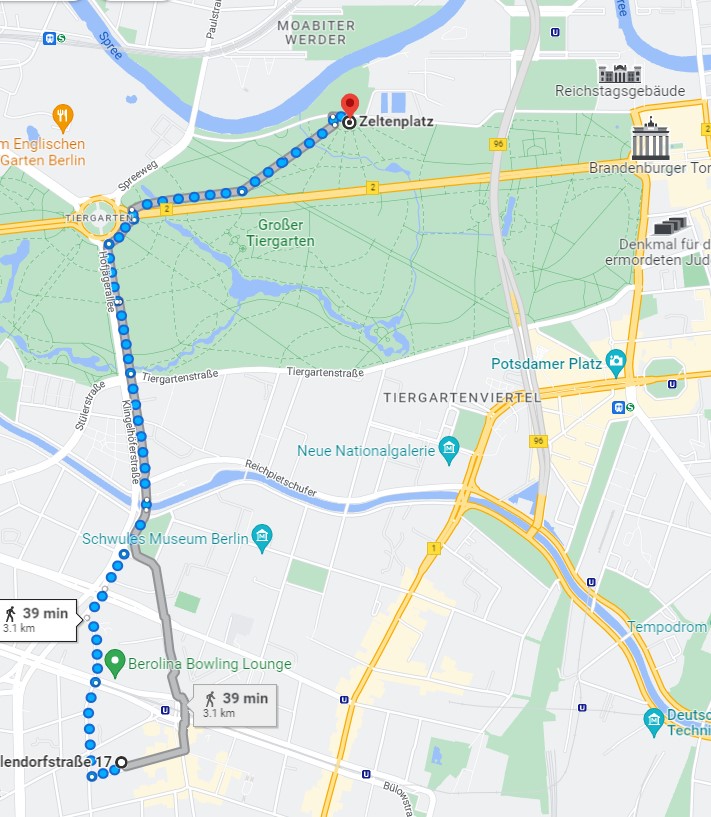Nollendorfstraße was just round the corner from Nollendorfplatz, a major intersection with a U-Bahn station.
East from Nollendorfplatz runs Bülowstraße. The Café Dorian Gray, a queer club was at Bülowstraße 57. Lotte Hahm's Violetta club was at Bülowstraße 37.
One street north of Nollendorfstraße was Motzstraße 15, where the Eldorado, Berlin's best-known trans nightclub had opened early in 1928.
Jean Ross (1911-1973) a lifelong feminist, Communist, war correspondent for both the right wing Daily Express and for the Comintern, actress, film critic, anti-fascist, film writer and more, lived on Bülowstraße, but at other times at Nollendorfstraße 17. Isherwood knew her and based his fictional character Sally Bowles on her. However she objected to being represented by an apolitical, non-feminist 'vulgar vamp', especially as portrayed by Liza Minnelli in the 1972 film of Cabaret.
 |
| Nollendorfstraße 17 today. Nr 24 did not survive the bombing in WWII |
It was a 3 km or 40 minute walk from the Institut für Sexualwissenschaft to Nollendorfstraße.
In Isherwood's Christopher and his Kind, 1976, Isherwood writes:
"Dr. Hirschfeld seldom ate with them. He was represented by Karl Giese, his secretary and long-time lover. Also present were the doctors of the staff and the patients or guests, whichever you chose to call them, hiding their individual problems behind silence or polite table chatter, according to their temperaments. I remember the shock with which Christopher first realized that one of the apparently female guests was a man. He had pictured transvestites as loud, screaming, willfully unnatural creatures. This one seemed as quietly natural as an animal and his disguise was accepted by everyone else as a matter of course. Christopher had been telling himself that he had rejected respectability and that he now regarded it with amused contempt. But the Hirschfeld kind of respectability disturbed his latent puritanism. During those early days, he found lunch at the Institute a bit uncanny." (p15).
"Then, one afternoon, André Gide paid them a visit. He was taken on a tour of the premises personally conducted by Hirschfeld. Live exhibits were introduced, with such comments as: “Intergrade. Third Division.” One of these was a young man who opened his shirt with a modest smile to display two perfectly formed female breasts. Gide looked on, making a minimum of polite comment, judiciously fingering his chin." (p17)
"During the Christmas season, a great costume ball was held in one of the dance halls of In den Zelten: a ball for men. Many of them wore female clothes. There was a famous character who had inherited a whole wardrobe of beautiful family ball gowns, seventy or eighty years old. These he was wearing out at the rate of one a year. At each ball, he encouraged his friends to rip his gown off his body in handfuls until he had nothing but a few rags to return home in." (p33)
That is it. The only mentions of trans persons in Isherwood's Christopher and his kind.
There is an interesting little snippet in Churton's The Beast in Berlin, p315:
"By way of contrast, [Aleister] Crowley had tea with "Christopher" (Isherwood) on 5 February (the diary's use of Christian name alone suggests Crowley must have liked him) in the company of Fanny, whose real name we discover, was Peter."
Actually Fanny, a young trans woman. was one of Crowley's several lovers.
Trans persons are also mainly not mentioned in Mr Norris Changes Trains (1935) and Goodbye to Berlin. Except as Norman Page discusses re the ending of the latter:
"The concluding section of Goodbye to Berlin offers not sequential narrative but a series of vignettes drawn from Isherwood's last winter in Berlin, and here he comes closer than ever before - though still not very close - to candour concerning his own sexuality and lifestyle. With a friend he goes on a tour of what are noncommittally referred to as `the dives' but which are plainly gay, lesbian and transvestite bars:
It was to be in the nature of a farewell visit, for the Police have begun to take a great interest in these places. They are frequently raided, and the names of their clients are written down. There is even talk of a general Berlin clean-up.
There is an unusually vivid snapshot of the grotesque glitz of contemporary Berlin nightlife (`a young man in a spangled crinoline and jewelled breast-caps' painfully does the splits), its outrageousness magnified through the eyes of an American tourist:
`Say,' he asked Fritz, `what's on here?'
`Men dressed as women,' Fritz grinned.
The little American simply couldn't believe it. `Men dressed as women? As women hey? Do you mean they're queer?'
`Eventually we're all queer,' drawled Fritz solemnly . . . .
`You queer, too, hey?' demanded the little American, turning suddenly on me.
`Yes,' I said, `very queer indeed.'
(Page p203, Isherwood p 190)
There were many interesting life stories going on around Isherwood, but he either was not aware, or chose not to retell them.
- Christopher Isherwood. Goodbye to Berlin. Penguin Books, 1945.
- Christopher Isherwood. Christopher and His Kind, 1929 - 1939. Farrar, Straus and Giroux, 1976.
- Norman Page. Auden and Isherwood: The Berlin Years. St martin's Press. 1998.
- Tobias Churton. Aleister Crowley The Beast in Berlin: Art, Sex, and Magick in the Weimar Republic. Inner Traditions, 2014




No comments:
Post a Comment
Comments that constitute non-relevant advertisements will be declined, as will those attempting to be rude. Comments from 'unknown' and anonymous will also be declined. Repeat: Comments from "unknown" will be declined, as will anonymous comments. If you don't have a Google id, I suggest that you type in a name or a pseudonym.